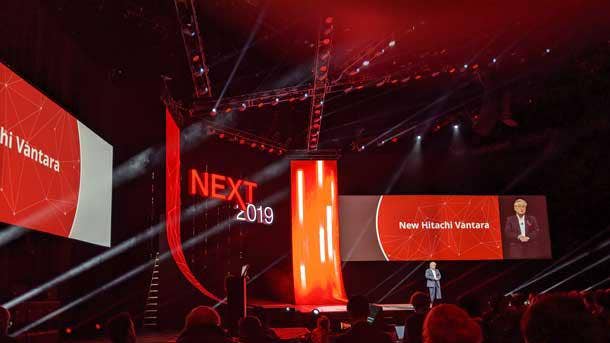Hitachi Vantara's Kim King: New Partner Portal Will Unify Resources
'We're really getting aggressive about how we communicate with them,' Hitachi Vantara channel executive Kimberly King says of the company's new online partner portal in an interview with CRN that also covers IoT adoption in the channel and other program changes

Channel Exec Talks New Portal, IoT Adoption, Other Program Changes
Hitachi Vantara plans to launch a new online portal next year that will make it easier for channel partners to do business with the company by bringing together disparate systems into a single interface with one login, according to channel executive Kimberly King.
In a recent interview with CRN, King, Hitachi Vantara's vice president of global partner strategy, said the new partner portal, set for launch in April 2020, has been her No. 1 priority after hearing from partners that they needed an easier way to access information and communicate with the company.
[Related: How Disney Parks Is Using Hitachi Vantara's Lumada To Improve Rides]
"All the feedback we got from partners was all around ease of doing business and communications," she said. "That was our No. 1 priority for them."
The new partner portal will provide access to customer and prospect information, including what products they're using and what their refresh cycle looks like. The portal will also include a marketing hub for partners as well as training and compliance programs.
King said the new portal will provide information based on a partner's attributes, which will be a "night-and-day" change from how it was previously done.
"We're looking at it from the perspective of who the partner is, what is their role and what type of partner are they in our program, and then it'll serve up data and information to them based on that," she said. "So we're really getting aggressive about how we communicate with them."
What follows is an edited transcript of CRN's interview with King, who also talked about the partner program's transition to a value-based model, partner adoption of Hitachi Vantara's Lumada and video IoT solutions and how the company is helping partners adopt such solutions.

One of the things you talked about last year was how Hitachi Vantara was changing its channel program from being a transactional, hardware-based program to something that is more value-based. How has that transition been going?
It's going great. We've really seen a huge adoption, especially from partners that sit outside of the pure reseller channel. The technology partners and the [global systems integrators], they, and even our managed service providers — they look at it from the perspective of where in the past they really had to earn through reselling. Now we do demand [generation] programs with them. We do all kinds of marketing activities, co-branding, all kinds of things that work with them, and they love that. So it's been good, a huge investment. We made tons of investments this year into programs that support that front-end piece of helping them find and adopt and drive our technologies.
When it comes to a value-based program, how do you measure that value?
So we look at influence from partners, which I think is No. 1. Even if a partner doesn't resell, they're there to influence an opportunity, or they may identify an opportunity and bring it to us. Like a GSI would typically not resell product, but they're the ones that are first on the ground, right? They're selling a much broader solution, and we're a component of that, and so we track, all of that, all of those pieces. So really sourced, influenced where they find it, that sort of thing — we're looking at all of those.
Does Hitachi Vantara still have tiers for partners?
We really got rid of the tiers last year. We tried to look at it more from an engagement model perspective. So, partners who engage actively with us, we're investing heavily back into them. Partners who do one deal a year? They're not going to get that same level of investment or engagement. Not that we don't support them through the process, but we found that partners, when they come to us and say, "here's my business plan, here's the activities that I want to roll out," we're going to invest with them over a 12-month period, they're really active with us. We have seen that engagement really increase.

So the tiers were eliminated last year?
We still sort of keep them internally, but they don't really mean anything. Tiers don't apply to all the business models, so tiers really only apply to a reseller, distributor. If you look at a "create" partner who's doing co-development with us for a GSI or a managed service provider partner, because their business is so different, you can't tier them. And so when it can't apply across all of the partners, there was no sense in us keeping them. People internally still say, "oh well, they used to be this or they used to be that." It just doesn't really work with their business model.
With the new value-based approach for the partner program, how do you differentiate between partners who are actually providing value versus scoring a certain amount of deals?
We actually have actively rolled out, and we use the IPED folks with your team [a consulting arm of The Channel Company, CRN's publisher] with our own internal team, to actively look at all of our partner community, and we taught them this business planning process. And so we sit down with our partners and do active joint business planning, which allows us to understand those partners that are highly engaged and want to grow the business versus the partners who [are considered lifestyle partners]. And so [it's] not that we don't pay attention to [the latter kind of partners]. We give them whatever they need. But if they're not going to actively participate, then we'll drive the value to those that drive a business plan and say we're going to do all these things with you.
So that's how we've been really monitoring it within the program. And so we actively measure them, we look at the business plan: How are they doing against those go-to-market [plans]? How are they doing against their accreditations? What activities are they doing? How many leads have we passed to them and they close? So we're really trying to keep a dashboard on the health of our partner community, so we can see how many are growing and what the process is. It's been pretty good this last year. Hopefully next year will be better. The more reports I get, the more data.

How has pickup been with Hitachi Vantara's Lumada IoT solutions for partners?
It's been interesting. We still see probably 20 or 30 percent of the partners adopting Lumada and they're interested in it. But we've had an increase of about 200-300 new partners over the last 18 months since I've been here. Primarily they come in as Pentaho partners, and they migrate to a Lumada partner. We're finding that the platforms, because they work very collaboratively, they are very interested in working within that solution. That has been working really well. So we're seeing that expansion and adoption going pretty great.
Are you seeing any particular use cases driving that adoption?
Really the ones that we rolled out initially around manufacturing. So anybody who has a [business around] manufacturing insights or that sort of go-to-market, we're seeing that they're adopting those, because think it's their natural business, and it's where the initial solutions wet to market.
I think they're trying to figure out what are the next solutions that they can take after that. And I think the Pentaho partners that we have are, they're the ones that will have those verticalized offerings, and they're going to drive the next-gen solutions for us.
I've spoken to some partners who have said that their way into IoT is through video applications like surveillance or behavioral analytics. How have partners been doing with Hitachi's video IoT offerings?
Great. I agree. I think the No. 1 is video, mostly around smart cities, smart spaces, this general idea. They love that, and so that is definitely their way into IoT. Because they can understand it, I think it's a nice stepping stone, and the more broader IoT is adopted and the more it becomes mainstream, I think we'll start to see them adopt all the other pieces as well.

What are you seeing more momentum with in the partner base: Lumada or the video solutions?
I would say video is probably more broad, so it is adopted by more partners, because it does naturally go with the rest of our core solutions. And I think Lumada, like I said, because it is a very data-rich, data [operations] solution, partners are starting — I think we will see a lot more adoption coming out of this.
I think the excitement, it will continually build. We had a line of partners after the meeting yesterday that said, "now you have everything, when can I get Jupiter [Hitachi Vantara's VSP 5000 storage platform]?" And the second thing was, "when are you going to have me training for the next-gen Lumada stuff?" And I said, we'll have that within the next 30 days. We rolled out today the Jupiter training for all partners. So we turned the switch on today, which is not normal for us because normally it takes a lot longer to do. We had been planning for that. The Lumada piece, we're recording it now, and within the next 30 days it'll be ready to go. We're being very focused on targeting partners that are ready to take advantage. We don't want to send it out to everyone and then they get confused. So we've been very focused on rolling things out and making sure that people can adopt it.
One partner told me that Hitachi Vantara has helped partners get into IoT solutions in some cases by providing its own people to lead certain opportunities in the beginning and then prepare partners to take over. Is that what is happening?
Yes, definitely. We've done a lot of mentoring programs and a lot of early adopter programs with these solutions. We want to make sure that they're successful and that they can take them over and be successful ongoing. So if you look at Lumada, if you look at — not so much Pentaho, that was much easier for them to adopt — but even the video solutions, we did a lot of the same things and now with [REAN Cloud] as well, we've been doing the same. We pick a specific number of partners. We did the training with them first. We have a mentor program with that. And then there's a whole group of partners below that [who] are ready for mentorship. So we've been very selective in the beginning, because we wanted to make sure we understood where were the potential pitfalls or roadblocks so that we could be successful [on a larger scale] rolling this out? We've done this slow wave. But the services team has been amazing and putting people in behind this and supporting our partner community.
How does an opportunity like that begin?
Typically, a partner identifies an opportunity, or we identify a partner [who] fits a profile that we want to target with them, and we'll have a conversation. If they want to commit the resources, we'll commit the resources. If they have an opportunity, then it goes a lot faster. And so we'll work through that, and it works. It's very nice. It's an easy engagement and easy support model.